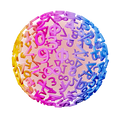
What Are Acute, Right and Obtuse Angles?
Video Crash Courses
Want to watch animated videos and solve interactive exercises about acute, obtuse and right angles?
Imagine riding a sled down a snow-covered hill in winter. Have you ever tried riding it on flat ground? Was it fun? I’ll assume it wasn’t, because you were probably just sitting still.
To get any speed on your sled, you need a hill. How steep the hill is can be described with an angle.

When the ends of two line segments meet at a point, they create an angle. We mark an angle by drawing an arc at the intersection. When two lines make an angle, we call them the sides of the angle.
There are three kinds of angles: Acute, right and obtuse.
Acute Angles
The first kind of angle we’ll look at is the acute angle. All angles smaller than ° are acute, meaning all angles smaller than a right angle are acute.
Right Angles
A light pole standing straight out of the ground forms an angle with the ground. This angle is called a right angle. A right angle is any angle equal to °. We often mark a right angle by drawing a square where the sides meet, instead of an arc, to make it obvious that it’s exactly °.
Obtuse Angles
Finally, we have obtuse angles. All angles that are larger than ° and smaller than ° are obtuse angles. This means that obtuse angles are angles that are larger than a right angle.
When you draw a line across another line, there are two things that can happen: Either you get two right angles, or you get one acute angle and one obtuse angle.
Think About This
Take a look at your protractor. Can you explain how it constructed?
As you can see from the printed marks and numbers on the protractor, it has an inner and an outer half circle, with degrees written on it. The inner circle goes from ° to ° in a counterclockwise direction, and the outer goes from ° to ° in a clockwise direction. (Some protractors are the opposite of what we have described here, but the concepts are the same.)
The protractor can be used in both directions—this is why it has degrees both in the clockwise and the anticlockwise direction. Make sure you always have a protractor when studying geometry.
Math Vault
Want to solve exercises about angles? Try Math Vault!























